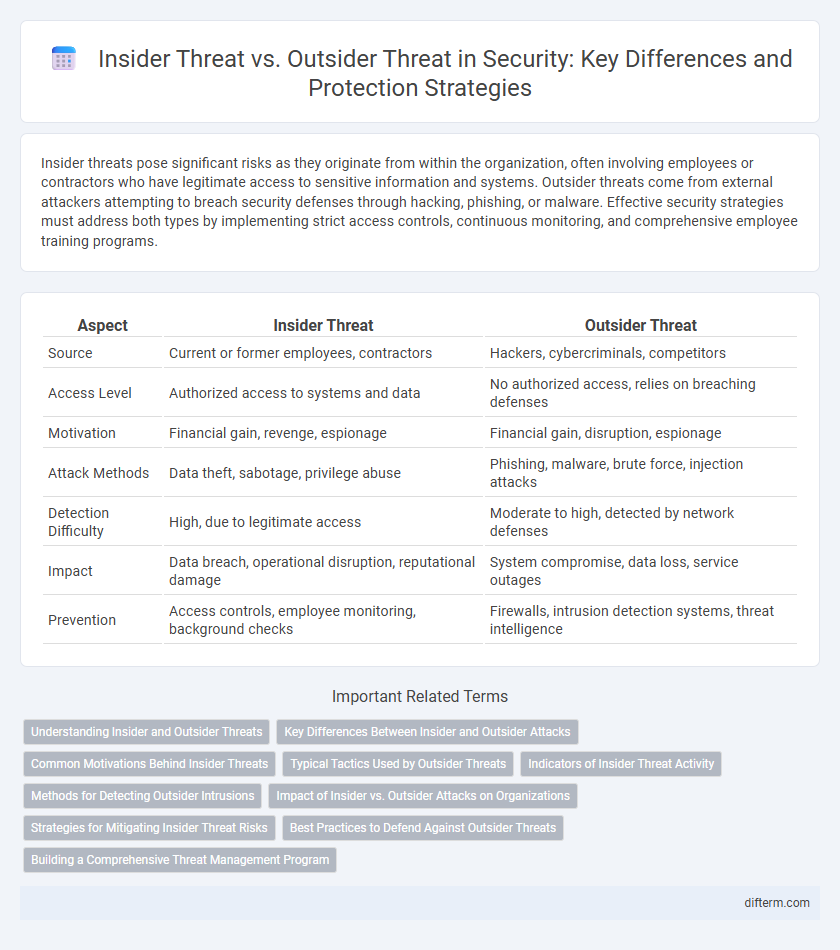Insider threats pose significant risks as they originate from within the organization, often involving employees or contractors who have legitimate access to sensitive information and systems. Outsider threats come from external attackers attempting to breach security defenses through hacking, phishing, or malware. Effective security strategies must address both types by implementing strict access controls, continuous monitoring, and comprehensive employee training programs.
Table of Comparison
| Aspect | Insider Threat | Outsider Threat |
|---|---|---|
| Source | Current or former employees, contractors | Hackers, cybercriminals, competitors |
| Access Level | Authorized access to systems and data | No authorized access, relies on breaching defenses |
| Motivation | Financial gain, revenge, espionage | Financial gain, disruption, espionage |
| Attack Methods | Data theft, sabotage, privilege abuse | Phishing, malware, brute force, injection attacks |
| Detection Difficulty | High, due to legitimate access | Moderate to high, detected by network defenses |
| Impact | Data breach, operational disruption, reputational damage | System compromise, data loss, service outages |
| Prevention | Access controls, employee monitoring, background checks | Firewalls, intrusion detection systems, threat intelligence |
Understanding Insider and Outsider Threats
Insider threats originate from individuals within an organization who have legitimate access but may misuse their privileges to compromise security, such as employees or contractors. Outsider threats involve external attackers like hackers or cybercriminals who attempt to breach defenses through phishing, malware, or other intrusion methods. Effective security strategies require continuous monitoring, behavior analysis, and robust access controls to mitigate risks posed by both insider and outsider threats.
Key Differences Between Insider and Outsider Attacks
Insider threats involve malicious actions from employees or trusted individuals with authorized access, while outsider threats originate from external attackers lacking legitimate credentials. Insider attacks often exploit privileged access to sensitive systems, making detection challenging, whereas outsider attacks rely on breaching security perimeters through phishing, malware, or brute force. Understanding these distinctions is crucial for implementing comprehensive security measures that address both internal vulnerabilities and external intrusions.
Common Motivations Behind Insider Threats
Insider threats often stem from motivations such as financial gain, retaliation, or ideological beliefs, making them particularly challenging to detect. Employees with access to sensitive data may exploit their privileges due to dissatisfaction, personal grievances, or external coercion. Understanding these motivations is crucial for developing effective security policies and mitigating risks associated with insider threats.
Typical Tactics Used by Outsider Threats
Outsider threats commonly employ tactics such as phishing, malware distribution, and ransomware attacks to exploit system vulnerabilities and gain unauthorized access. Social engineering techniques are frequently used to deceive employees into divulging sensitive information or credentials. Exploiting software vulnerabilities through zero-day attacks and brute force password attempts also remain prevalent methods in outsider threat strategies.
Indicators of Insider Threat Activity
Indicators of insider threat activity often include unexpected access to sensitive data, unusual login times, and repeated attempts to bypass security protocols. Behavioral changes such as increased secrecy, disgruntlement, or sudden financial difficulties may also signal potential insider risks. Monitoring anomalous system activity, including data exfiltration patterns and unauthorized use of privileged accounts, enhances early detection of insider threats.
Methods for Detecting Outsider Intrusions
Effective methods for detecting outsider intrusions include network traffic analysis, anomaly detection systems, and intrusion detection systems (IDS) that monitor for unusual patterns indicating potential breaches. Utilizing machine learning algorithms enhances threat identification by analyzing large data sets for irregular activities in real-time. Combining signature-based detection with behavioral analytics improves accuracy in pinpointing external threats before significant damage occurs.
Impact of Insider vs. Outsider Attacks on Organizations
Insider threats often cause deeper damage to organizations due to privileged access that allows manipulation of sensitive data, leading to significant financial loss and reputational harm. Outsider threats typically rely on breaching external defenses, but their impact can escalate rapidly if they gain access to critical systems. Organizations face higher risks from insider attacks because insiders understand internal processes and security gaps, enabling more targeted and difficult-to-detect breaches.
Strategies for Mitigating Insider Threat Risks
Implementing robust access controls and continuous user activity monitoring significantly reduces insider threat risks by limiting unauthorized data exposure and detecting suspicious behaviors early. Regular employee training on security protocols and fostering a culture of transparency enhance awareness and accountability, minimizing the likelihood of internal security breaches. Deploying advanced analytics and behavioral-based detection systems enables timely identification of malicious insiders, strengthening overall organizational security posture.
Best Practices to Defend Against Outsider Threats
Effective defense against outsider threats relies on robust perimeter security measures, including firewalls, intrusion detection systems (IDS), and multi-factor authentication (MFA) to prevent unauthorized access. Regular software patching, real-time network monitoring, and employee training on phishing prevention significantly reduce vulnerabilities exploited by external attackers. Implementing zero trust architecture and maintaining comprehensive incident response plans further strengthen protection against data breaches and cyberattacks initiated from outside the organization.
Building a Comprehensive Threat Management Program
A comprehensive threat management program integrates both insider and outsider threat detection by leveraging advanced behavioral analytics and real-time monitoring systems. Prioritizing identity and access management (IAM) alongside anomaly detection tools helps mitigate risks posed internally and externally. Effective programs combine continuous employee training, robust endpoint security, and layered network defenses to address the multifaceted nature of modern cyber threats.
Insider Threat vs Outsider Threat Infographic

 difterm.com
difterm.com